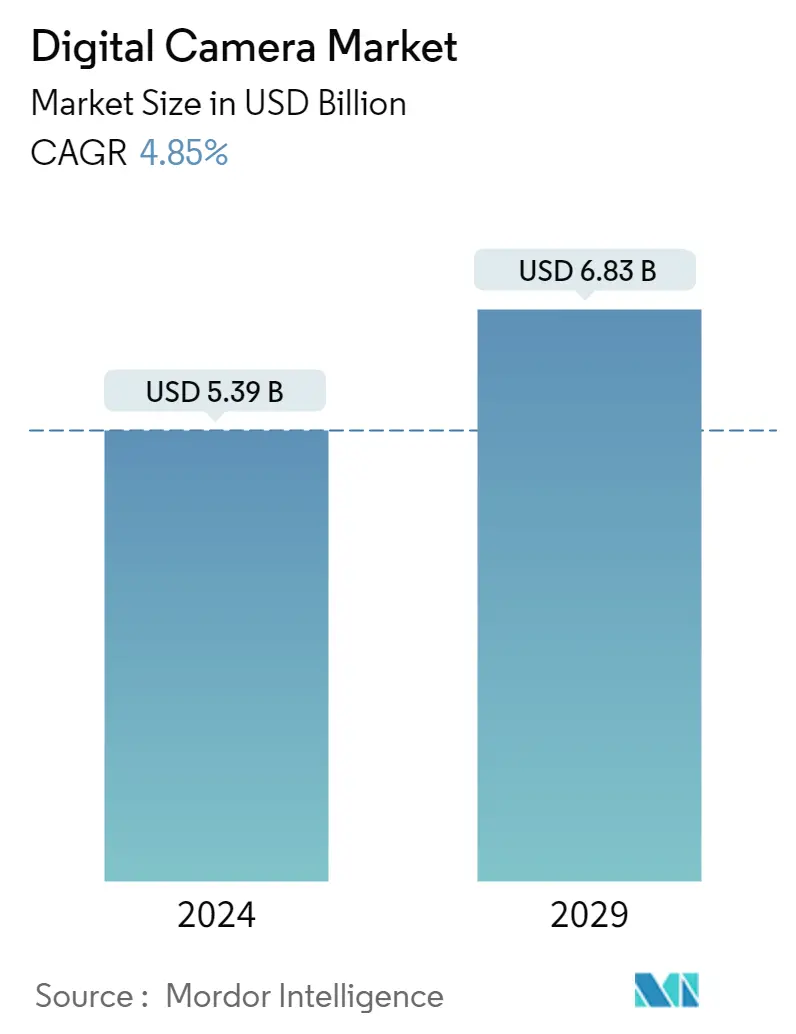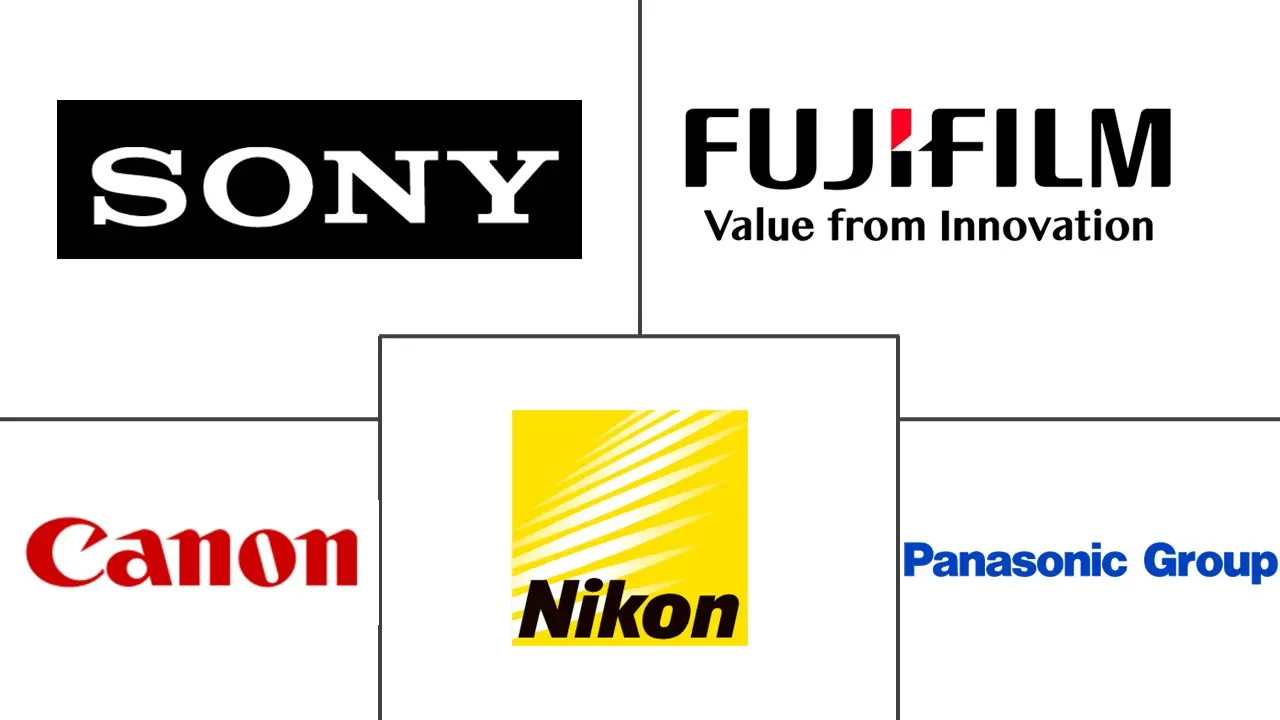Market Size of Digital Camera Industry

| Study Period | 2019 - 2029 |
| Market Size (2024) | USD 5.39 Billion |
| Market Size (2029) | USD 6.83 Billion |
| CAGR (2024 - 2029) | 4.85 % |
| Fastest Growing Market | Asia-Pacific |
| Largest Market | Asia Pacific |
Major Players
*Disclaimer: Major Players sorted in no particular order |
Digital Camera Market Analysis
The Digital Camera Market size is estimated at USD 5.39 billion in 2024, and is expected to reach USD 6.83 billion by 2029, growing at a CAGR of 4.85% during the forecast period (2024-2029).
The market is studied based on the revenue generated from the sale of digital cameras across the world.
- The growth rate of the global digital camera market is expected to decline over the forecast period, owing to shifting consumer preference toward smartphone cameras. Global digital camera shipments have been witnessing a downfall in sales in the last decade. Most of the major digital camera manufacturers have also recorded a decline and fluctuating sales in the past few years.
- Numerous types of digital cameras were available, and the marketplace was rather crowded. However, the manufacturers, Nikon and Canon, created the full frame camera for a niche customer base that desired quicker shutters, better resolution, and more clarity. These were for professionals, such as sports and wedding photographers, who earned a living from photography, and a lousy shot could negatively affect their business.
- However, the recent advancements in technology and the growing number of digital photography platforms and social media platforms have created new opportunities for the vendors in the market studied. The numerous product launches with feature upgrades in recent years, along with newer payment methods and camera services, are expected to aid the growth of the market studied. Major players, such as Nikon, Sony, Canon, and Fujifilm, are introducing innovations in the field of mirrorless cameras and are highly optimistic about their adoption.
- The quality of smartphone cameras has improved dramatically in recent years. Most individuals no longer need to carry or purchase a dedicated camera. While photo enthusiasts and professionals are expected to obtain superior results with high-end lenses and cameras, current smartphones produce images that are certainly enough for the average consumer's needs.
- Various travel bans imposed across different countries during COVID-19 created a loss of income for professional photographers, leading to the lack of resources to purchase new models of cameras. This had decreased the demand for digital camera production. However, after the pandemic, the market is growing rapidly due to the launch of new products. This growth is further supported by the lifitng of travel bans, providing the opportunity to expand the market.
Digital Camera Industry Segmentation
The global digital camera market covers the revenue generated from the shipment value of digital cameras worldwide. The study tracks the demand for the digital camera market based on lens type, camera type, end-users, and geography. The market also covers the major micro- and macro-economic factors impacting the growth of the market studied in terms of drivers and restraints.
The scope of the study focuses on the market analysis of digital cameras worldwide. Market sizing encompasses the value of the total number of shipments globally. The study also tracks the key market parameters, underlying growth influencers, and major vendors operating in the industry, expected to support the market estimations and growth rates over the forecast period. The study further analyzes the overall impact of COVID-19 on the ecosystem. The report's scope encompasses market sizing and forecast for segmentation by lens type, camera type, end-users, and geography. The market sizes and forecasts are provided in terms of value (USD million) for all the above segments.
| By Lens Type | |
| Built-in | |
| Interchangeable |
| By Camera Type | |
| Compact Digital Camera | |
| DSLR | |
| Mirrorless |
| By End-user | |
| Pro Photographers | |
| Prosumers | |
| Hobbyists |
| By Geography | |
| North America | |
| Europe | |
| Asia-Pacific | |
| Latin America | |
| Middle East & Africa |
Digital Camera Market Size Summary
The digital camera market is experiencing a dynamic phase, characterized by a shift in consumer preferences towards smartphone cameras, which has led to a decline in global digital camera shipments over the past decade. Despite this trend, major manufacturers like Nikon and Canon have carved out a niche by developing full-frame cameras aimed at professional photographers who require high-quality images for their work. The market remains competitive, with key players such as Sony, Fujifilm, and Canon focusing on innovations in mirrorless cameras to capture a larger share of the market. These advancements, coupled with the rise of digital photography and social media platforms, are creating new opportunities for growth. The introduction of feature-rich products and innovative payment methods is expected to bolster the market's expansion during the forecast period.
The Asia-Pacific region is poised to be a significant contributor to the digital camera market, driven by the presence of major companies and a growing interest in photography. The region's increased disposable income and enthusiasm for photography, along with the rising demand for wedding photography, are expected to further stimulate market growth. Despite the challenges posed by the smartphone industry, digital camera manufacturers are focusing on product launches and technological advancements to meet the diverse needs of consumers. The market's recovery post-COVID-19, supported by the lifting of travel bans and the introduction of new products, is anticipated to continue, with mirrorless cameras gaining traction over traditional DSLRs. This trend is expected to drive demand for mirrorless lenses and other related products, as companies invest in developing unique and improved photography solutions.
Digital Camera Market Size - Table of Contents
-
1. MARKET DYNAMICS
-
1.1 Market Drivers
-
1.1.1 Anticipated Increase in Sales of Mirror-less Lens
-
1.1.2 Demand for Specialized Products from Niche Customer Base
-
-
1.2 Market Challenges
-
1.2.1 Strong Competition from Smartphones with Advanced Features
-
1.2.2 Growing Trend Towards Camera Rentals
-
-
1.3 Key Technological Innovations - Mirrorless Lens and Accessories
-
1.4 Historical Trend Analysis of Digital Camera Sales (1999-2021)
-
-
2. MARKET SEGMENTATION
-
2.1 By Lens Type
-
2.1.1 Built-in
-
2.1.2 Interchangeable
-
-
2.2 By Camera Type
-
2.2.1 Compact Digital Camera
-
2.2.2 DSLR
-
2.2.3 Mirrorless
-
-
2.3 By End-user
-
2.3.1 Pro Photographers
-
2.3.2 Prosumers
-
2.3.3 Hobbyists
-
-
2.4 By Geography
-
2.4.1 North America
-
2.4.2 Europe
-
2.4.3 Asia-Pacific
-
2.4.4 Latin America
-
2.4.5 Middle East & Africa
-
-
Digital Camera Market Size FAQs
How big is the Digital Camera Market?
The Digital Camera Market size is expected to reach USD 5.39 billion in 2024 and grow at a CAGR of 4.85% to reach USD 6.83 billion by 2029.
What is the current Digital Camera Market size?
In 2024, the Digital Camera Market size is expected to reach USD 5.39 billion.

